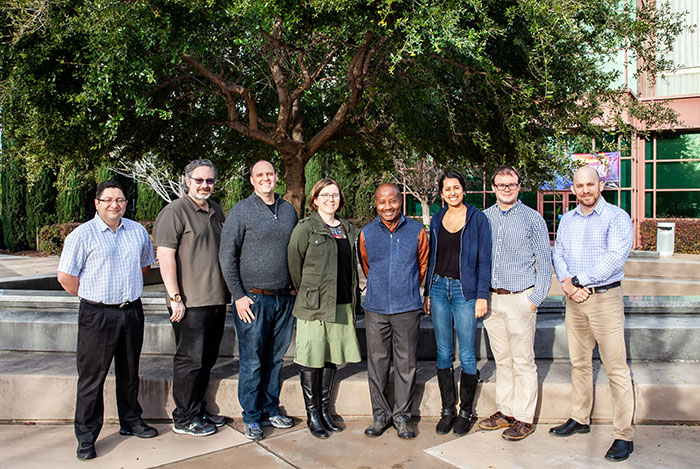LLNL’s Virtual Beam Line ++ Now Available to Users
April 3, 2019
 The VBL++ Agile Scrum Team (from left): Jean Michel Di Nicola, Tom Epperly, Jarom Nelson, Kathleen McCandless, Maxwell Osawe, Ashka Shah, Sam Schrauth, and Barry Fishler. Credit: Jason Laurea
The VBL++ Agile Scrum Team (from left): Jean Michel Di Nicola, Tom Epperly, Jarom Nelson, Kathleen McCandless, Maxwell Osawe, Ashka Shah, Sam Schrauth, and Barry Fishler. Credit: Jason Laurea Physicists designing new laser systems and modeling laser performance at LLNL now have a powerful new tool in their hands with the Rigel release of Virtual Beam Line++ (VBL++). The current version of VBL, a java-based code, has been in use since 2000.
VBL++ has a new architecture using the C++ code and best-in-class standards to enable high-resolution simulations on the Laboratory’s High-Performance Computing platform.
VBL’s goal is to predict all aspects of laser performance by solving Maxwell’s electromagnetism and optics equations to model beam propagation/diffraction, amplification, nonlinear frequency conversion, and other nonlinear effects in vacuum, gas, or a dielectric (non-conducting) medium. It answers the need for accurate, efficient, and user-friendly physics simulations required to design and operate laser systems.
“The new VBL software leverages high-performance computing and existing software packages developed at LLNL, such as RAJA and SUNDIALS, for enhanced precision and performance modeling,” said Barry Fishler, the software engineering lead. “VBL++ is a necessity for addressing the complexities for our next major upgrade: supporting broadband beam propagation and amplification for short-pulse and high-repetition rate laser architectures.”
Other members of the software engineering team include Tom Epperly, Kathleen McCandless, Ashka Shah, Jarom Nelson, and Maxwell Osawe. The physics models for these capabilities are being developed and prototyped by the NIF& PS Directorate with Jean Michel Di Nicola (VBL++ project and laser physics team lead), Thomas Lanier, Gabriel Mennerat, Francis Morrissey, Rick Sacks, Samuel Schrauth, and Michael Erickson.
The Rigel release, in development for the past two years, is the third successful milestone for the project but the first major release to users. The team has demonstrated VBL++ matches or surpasses the capabilities and accuracy of the Java version that is currently the physics engine behind the Laser Performance and Operations Model (LPOM) software used for the daily laser setup, execution, and analysis of NIF experiments.
In a separate effort later in 2019, the LPOM software team will complete the integration of VBL++ into LPOM and demonstrate its use for shot setup analysis. Once operationally qualified, the two products will fulfill a critical role in validating NIF experiments and ensuring machine safety and laser performance delivery during experiment planning and execution.
Over the rest of Fiscal Year 2019, the VBL++ team will implement a modern graphical user interface and further expand simulation capabilities. Future capabilities are planned to support high-energy, high-peak, and high-repetition-rate laser systems with the preparation for broadband light propagation and amplification as well as birefringence effects in a high-performance computing environment.
—Patricia Koning
Follow us on Twitter: @lasers_llnl



